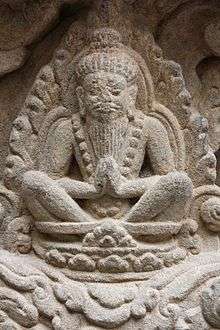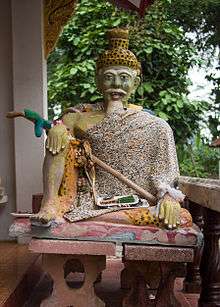Rishi
Rishi (Sanskrit: ऋषि, IAST: ṛṣi) is a Vedic term for an accomplished and enlightened person. Rishis have composed hymns of the Vedas. Post-Vedic tradition of Hinduism regards the rishis as "great sadhus" or "sages" who after intense meditation (tapas) realized the supreme truth and eternal knowledge, which they composed into hymns.[1]

Etymology
According to Indian tradition, the word may be derived from two different meanings of the root 'rsh' (ṛṣ). Sanskrit grammarians[2] derive this word from the second meaning: "to go, to move".[3] V. S. Apte[4] gives this particular meaning and derivation, and Monier-Williams[5] also gives the same, with some qualification.
Another form of this root means "to flow, to move near by flowing". (All the meanings and derivations cited above are based upon Sanskrit English Dictionary of Monier-Williams).[5] Monier-Williams also quotes Tārānātha who compiled the great (Sanskrit-to-Sanskrit) dictionary named "ṛṣati jñānena saṃsāra-pāram" (i.e., "one who reaches beyond this mundane world by means of spiritual knowledge").
More than a century ago, Monier-Williams tentatively suggested a derivation from drś "to see".[6] Monier-Williams also quotes the Hibernian (Irish) form arsan (a sage, a man old in wisdom) and arrach (old, ancient, aged) as related to rishi. Monier-Williams also conjectures that the root drish (to see) might have given rise to an obsolete root rish meaning "to see".
However, the root has a close Avestan cognate ərəšiš[7] "an ecstatic" (see also Yurodivy, Vates). Yet the Indo-European dictionary of Julius Pokorny connects the word to a PIE root *h3er-s meaning "rise, protrude", in the sense of "excellent" and thus cognate with Ṛta and right and Asha. In Sanskrit, forms of the root rish become arsh- in many words, (e.g., arsh)
Modern etymological explanations such as by Manfred Mayrhofer in his Etymological Dictionary[8] leave the case open, and do not prefer a connection to ṛṣ "pour, flow" (PIE *h1ers), rather one with German rasen "to be ecstatic, be in a different state of mind" (and perhaps Lithuanian aršus).
"Seer" of the Vedas

In the Vedas, the word denotes an inspired poet of Vedic hymns.[1] In particular, Ṛṣi refers to the authors of the hymns of the Rigveda. Some of the earliest lists of Rishi are found in Jaiminiya Brahmana verse 2.218 and Brihadaranyaka Upanishad verse 2.2.6.[9]
Post-Vedic tradition regards the Rishis as "sages" or saints, constituting a peculiar class of divine human beings in the early mythical system, as distinct from Asuras, Devas and mortal men. Swami Vivekananda described "Rishi"s as Mantra-drashtas or "the seers of thought". He told— "The truth came to the Rishis of India — the Mantra-drashtâs, the seers of thought — and will come to all Rishis in the future, not to talkers, not to book-swallowers, not to scholars, not to philologists, but to seers of thought."[10]
The notable female rishikas who contributed to the composition of the Vedic scriptures are: The Rig Veda mentions Romasha, Lopamudra, Apala, Kadru, Visvavara, Ghosha, Juhu, Vagambhrini, Paulomi, Yami, Indrani, Savitri and Devayani. The Sama Veda adds Nodha, Akrishtabhasha, Sikatanivavari and Gaupayana.
In Mahabharata 12, on the other hand, there is the post-Vedic list of Marīci, Atri, Angiras, Pulaha, Kratu, Pulastya and Vashista. The Mahābhārata list explicitly refers to the saptarshis of the first manvantara[5] and not to those of the present manvantara. Each manvantara had a unique set of saptarshi. In Harivamsha 417ff, the names of the Rishis of each manvantara are enumerated.
In addition to the Saptarṣi, there are other classifications of sages. In descending order of precedence, they are Brahmarshi, Maharshi, Rajarshi. Devarṣi, Paramrṣi, Shrutarṣi and Kāndarṣi are added in Manusmriti iv-94 and xi-236 and in two dramas of Kālidasa.
The Chaturvarga-Chintāmani of Hemādri puts 'riṣi' at the seventh place in the eightfold division of Brāhmanas. Amarakosha[11] (the famous Sanskrit synonym lexicon compiled by Amarasimha) mentions seven types of riṣis : Shrutarshi, Kāndarshi, Paramarshi, Maharshi, Rājarshi, Brahmarshi and Devarshi. Amarakosha strictly distinguishes Rishi from other types of sages, such as sanyāsi, bhikṣu, parivrājaka, tapasvi, muni, brahmachāri, yati, etc.
Rishi in Indonesia and Khmer temples
Most medieval era Hindu temples of Java, Indonesia show Rishi Agastya statues or reliefs, usually guarding the southern side of Shaivite temples.[9] Some examples include Candi Sambisari and the Prambanan temple near Yogyakarta.[12] Rishi Agastya is known as Phra Reusi Akkhot in Thailand.[9]
Ruesi in Cambodia, Thailand, Myanmar and Laos

Ruesi (sanskrit: ṛṣi, Khmer: តាឥសី, Thai: ฤๅษี, Lao: ລືສີ) is a hermit sage, the equivalent of Rishi in India. In Myanmar, there are some known as ရေသ့ Rase.
Other uses
Rishi is also a male given name, and less commonly a Brahmin last name.
In Carnatic music, "Rishi" is the seventh chakra (group) of Melakarta ragas. The names of chakras are based on the numbers associated with each name. In this case, there are seven rishis and hence the 7th chakra is "Rishi".[13][14]
The descendant families of these Rishis, refer to their ancestral lineage through their family "gotra". This is a common practice among the Brahmin sects of the current Hindu society.
The name "Rishi" (pronounced "ruesi") is also the basis of one of the letters of the Thai alphabet, so reu-si (Thai: ษ ฤๅษี).
See also
Notes
- Hartmut Scharfe (2002), Handbook of Oriental Studies, BRILL Academic, ISBN 978-9004125568, pages 13–15
- cf. Commentary on Unadi-Sutra, iv, 119
- Dhātupāṭha of Pānini, xxviii). V. S. Apte
- V. S. Apte (Sanskrit-Hindi Kosh, 1890, reprint 1997 by Motilāl Banārasidās Publishers, Delhi)
- Monier-Williams, Monier (1899), A Sanskrit-English Dictionary, Delhi: Motilal Banarsidass, p. 226
- http://flaez.ch/cgi-bin/mw.pl?query=RSi
- Yasna 31.5; cf. 40.4
- Etymologisches Wörterbuch des Altindoarischen, Heidelberg 1986, I 261
- Justin McDaniel (2013), This Hindu holy man is a Thai Buddhist, South East Asia Research, Volume 21, Number 2, page 309, 303-321
- "Swami Vivekananda on Rishis". Swami Vivekananda Quotes. Retrieved 12 April 2014.
- Amarakosha (2.7.41–42)
- Maud Girard-Geslan et al (1997), Art of Southeast Asia, Harry Abrams, Paris, page 350
- South Indian Music Book III, by Prof. P Sambamoorthy, Published 1973, The Indian Music Publishing House
- Ragas in Carnatic music by Dr. S. Bhagyalekshmy, Pub. 1990, CBH Publications
References
- Apte, Vaman Shivram (1965), The Practical Sanskrit-English Dictionary (Fourth Revised and Enlarged ed.), New Delhi: Motilal Banarsidass, ISBN 978-81-208-0567-5
- Apte, Vaman Shivram (1966), Sanskrit-Hindi Koṣa (Reprint 1997 ed.), New Delhi: Motilal Banarsidass
- Chopra, Deepak (2006), Life After Death: The Burden of Proof (first ed.), Boston: Harmony Books
- Kosambi, D. D. (1956), An Introduction to the Study of Indian History (Second ed.), Bombay: Popular Prakashan Pvt Ltd, 35c Tardeo Road, Popular Press Bldg, Bombay-400034
- Śāstri, Hargovind (1978), Amarkoṣa with Hindi commentary, Vārānasi: Chowkhambā Sanskrit Series Office